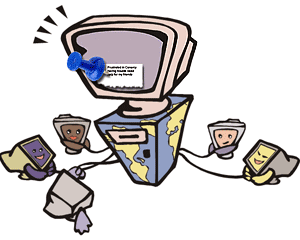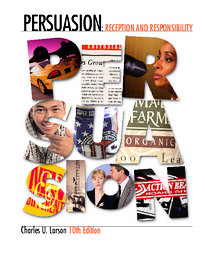Back to Buerkle's Persuasion Main Page | Back to Buerkle's Faculty Page
Persuasion
Department of Communication, East Tennessee
State University, Summer 2006
SPCH
3390-504, Online Only
C. Wesley Buerkle, Ph.D. (berkley) Office Hours
Office: Warf-Pickel 528 T/R 1:00-2:00 (in office)
Office Phone: 439-7579* T/R 12:00-1:00 (chat room)
E-mail: buerkle@etsu.edu By Appointment

REQUIRED MATERIALS
§
Larson, Charles U. Persuasion: Reception and
Responsibility. 10th ed. Belmont, CA: Thomson, 2004.
§
The 11th edition just came out; buy whichever
you like.
§ Cialdini, Robert. Influence: The Psychology of Persuasion. Rev. New York: Collins, 1998.
|
|
|
GOALS
This course aims to enable you, the student, with an in-depth understanding of persuasive principles such that you can identify and critique the many strategies we encounter on a daily basis. When you leave the course you should be able to recognize the persuasive strategies used in interpersonal and mass communication settings, critique the effectiveness of the strategies used, and offer suggestion for how the strategies might be changed or insight into the implications of the strategies used.
ASSIGNMENTS
Cialdini Group Presentation – 10%
The class will separate into groups and work cooperatively to prepare for the class a presentation of an assigned chapter from Cialdini’s Influence. The presentations should clearly outline and explain the major concepts of the book without copying right from Cialdini. Most importantly, you should invest the presentation with examples and explorations of your own: they should NOT restate Cialdini’s examples. The idea of the presentation is for you to reflect on and offer other applications of Cialdini’s concepts than what you find in his text. The resulting presentation will be a concise study aide and “real life” supplement to Cialdini. I am looking for clarity of content as well as creativity. Be sure to have fun with this!
 The presentations will be
performed by creating and posting to BlackBoard a single Word document,
PowerPoint file, or website for the group’s chapter. You need to incorporate
visual elements into your presentation so that we are not simply reading
block texts or outlines. Be sure you break out the written content into well
organized and easy to read segments. Develop and post three discussion board
questions to engage your audience in the presentation (e.g., asking them if
they have had a particular experience or if they have ever engaged in a
certain behavior). These question will provide post-presentation discussion
for the class.
The presentations will be
performed by creating and posting to BlackBoard a single Word document,
PowerPoint file, or website for the group’s chapter. You need to incorporate
visual elements into your presentation so that we are not simply reading
block texts or outlines. Be sure you break out the written content into well
organized and easy to read segments. Develop and post three discussion board
questions to engage your audience in the presentation (e.g., asking them if
they have had a particular experience or if they have ever engaged in a
certain behavior). These question will provide post-presentation discussion
for the class.
When you post your presentation you will also submit to me, in a separate document, three suggested multiple choice exam questions (with the answer).
If there are any problems in your group, please see me immediately so we can work together to resolve/ manage the situation. Part of your grade will come from how your fellow group members evaluate your participation.
Social-Behavioral
Research Project – 20%
For this project you will conduct an experiment employing a theory from class content. You can work alone or with a partner to develop and execute an experiment that applies a persuasive theory to some kind of human behavior. Your project must receive my approval by the date on the schedule. On the day the project is due you will turn in a 5-6 page paper discussing your research process and findings. The paper must include at least three academic research articles (not websites) of similar research already done in the field.
All students will provide a presentation on their research findings. For the presentation you will post a Word document, PowerPoint file, or webpage that briefly covers your hypotheses, literature review, method, findings, and conclusion. All students will read and respond to at least five other students’ presentations.
Social Movement Analysis – 20%
For this project you will analyze the persuasive messages produced by the social-movement group of your choice. Using the readings on social movements, you will examine the life-cycle of and persuasive efforts used by the organization you have decided to study. You must have your analysis choice approved by the date on the class schedule. The 5-6 page paper will include at least two academic articles (not websites) that use the same means of analysis as you (e.g., feminist, Burkean, etc.) and two substantial sources (i.e., books or articles but not brief websites) about your social movement/ group.
As before, you will provide a presentation on their research findings. For the presentation you will post a Microsoft Word document, PowerPoint file, or webpage that briefly covers your hypotheses, literature review, method, findings, and conclusion. All students will read and respond to at least five other students’ presentations.
Throughout the course I will present you with class activities you will be responsible for completing in your group. You will be assigned to a group at the beginning of the term. You and your group members will responsible for completing the activity by discussing it within your group’s own discussion board and then sharing your answers with the rest of the class. The instructions for the individual assignments can be found in BlackBoard.
Discussion Board Participation – 10%
 Three times a week (once be
Monday, twice by Wednesday, and thrice by Friday) discussion question will
be posted by me, the professor. You will be required to provide a
significant response to the thread (the original question or a response
already posted for that question) and two follow-up posts. Significant
responses specifically address course content, from lecture or reading.
They also provide some kind of example to make your point. You may make as
many posts as you like, but you need one significant post and only one will
be graded. Two paragraphs will suffice. Sometimes, the posted question may
ask you to engage in some kind of activity first (e.g., finding a sample
image to post or reading a webpage). Posts will receive a grade of
P (1 pt. [for posts that do
the job well and therefore receive full credit]),
P+ (1.3 pts. [for outstanding
contributions that receive a little extra]),
P- (.7 pts. [for posts that
fall short of the expectations]), or 0 (for missing or non-contributory
posts). Follow-up responses respond to other students’ posts by
offering some kind of useful comment (e.g., “I had a similar experience when
. . . .”). These are due by 11:59 PM, Sunday. Feel free to post more than
the required number, but be sure to meet the minimum requirement.
Three times a week (once be
Monday, twice by Wednesday, and thrice by Friday) discussion question will
be posted by me, the professor. You will be required to provide a
significant response to the thread (the original question or a response
already posted for that question) and two follow-up posts. Significant
responses specifically address course content, from lecture or reading.
They also provide some kind of example to make your point. You may make as
many posts as you like, but you need one significant post and only one will
be graded. Two paragraphs will suffice. Sometimes, the posted question may
ask you to engage in some kind of activity first (e.g., finding a sample
image to post or reading a webpage). Posts will receive a grade of
P (1 pt. [for posts that do
the job well and therefore receive full credit]),
P+ (1.3 pts. [for outstanding
contributions that receive a little extra]),
P- (.7 pts. [for posts that
fall short of the expectations]), or 0 (for missing or non-contributory
posts). Follow-up responses respond to other students’ posts by
offering some kind of useful comment (e.g., “I had a similar experience when
. . . .”). These are due by 11:59 PM, Sunday. Feel free to post more than
the required number, but be sure to meet the minimum requirement.
2 Exams x 15%
Exams will be posted and available only on the date listed on the “Class Schedule.” Exams may only be made up when the absence is a university excused activity, necessary documentation is provided, and arrangements for make up are made in advance. Exams may be multiple choice, short answer, true/ false, matching, essay, or any combination thereof. A study guide will be provided before each exam.
Due Dates & Late Work
All assignments and exams are due by 11:59 PM on the date assigned. Exams will not be available for completing or submitting after the due date. Papers and presentations submitted after the deadline will receive a 20% penalty. No work will be accepted more than 24 hrs. after the deadline. Discussion posts are due according to the description above. No extensions or late credit will be given.
Academic Integrity
Plagiarism or otherwise cheating will not be tolerated in this course and is grounds for a failing on that work or in the course as a whole, depending upon the severity of the infraction. You can also expect I will report you to your dean.
Appeals
![]() To appeal a grade on an
assignment you must submit a type-written explanation within one week of the
assignment being returned to the class. Please, wait 24 hrs. before
approaching me about your grade on an assignment.
To appeal a grade on an
assignment you must submit a type-written explanation within one week of the
assignment being returned to the class. Please, wait 24 hrs. before
approaching me about your grade on an assignment.
